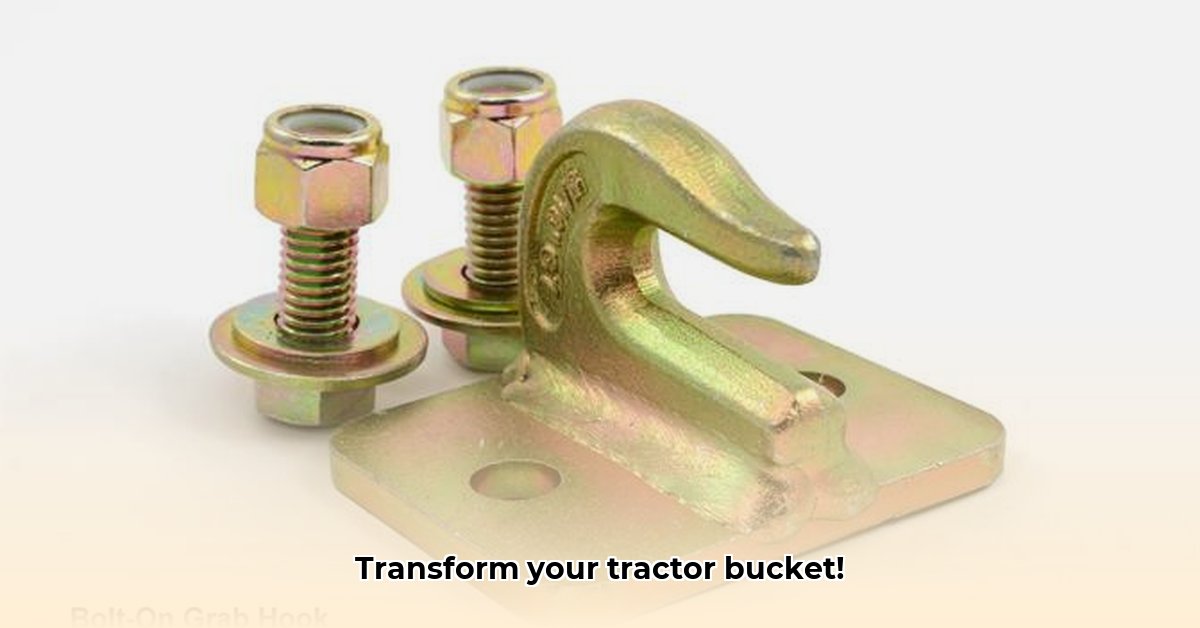
Choosing the right chain hook for your tractor bucket can significantly improve your farm's efficiency and save you both time and money. This comprehensive guide covers selecting, installing, and maintaining these essential tools, ensuring both safety and optimal performance. We'll examine bolt-on and weld-on options, helping you choose the perfect hook for your specific needs and farming practices. For even more power, consider a tractor attachment.
Choosing the Right Chain Hook
Before purchasing, consider your specific needs. What materials will you be handling? Think about weight, size (bales, logs, etc.), and density. How frequently will you use the hooks? Heavy, frequent use demands a more robust hook. Finally, ensure compatibility with your tractor bucket's design and mounting points. Don't underestimate the importance of this initial assessment; it directly impacts your hook selection.
Hook Types: Bolt-On vs. Weld-On
The primary choice lies between bolt-on and weld-on hooks. Each offers unique advantages and disadvantages.
Bolt-On Hooks:
- Pros: Easy installation and replacement; ideal for occasional use; requires fewer specialized tools.
- Cons: Potentially less strong than weld-ons; may loosen over time if not properly tightened; more limited placement options.
Weld-On Hooks:
- Pros: Significantly stronger; permanent placement ensures better load distribution; greater placement flexibility.
- Cons: Requires welding expertise; more difficult and costly to repair or replace; necessitates specialized tools and safety precautions.
Material Matters: Strength and Durability
The hook's material directly impacts its durability and lifespan. Common choices include hardened steel, offering excellent strength and longevity (though potentially more expensive), and galvanized steel, providing corrosion resistance and cost-effectiveness. Your choice should consider your climate and budget. A weak hook is a safety hazard.
Weight Capacity: A Critical Safety Factor
Always select hooks with a weight capacity significantly exceeding the heaviest load anticipated. Overloading is a major safety risk, potentially causing breakage and injury. A significant safety margin is crucial. How much weight do you regularly lift? Choosing a hook with the appropriate capacity is vital for accident prevention.
Safety Considerations: Prioritizing Safe Practices
Safe handling is paramount. Use only high-quality hooks from reputable manufacturers. Before each use, thoroughly inspect the hook for any signs of wear, damage, or corrosion. Replace any damaged hooks immediately. Following manufacturer instructions during installation and usage is essential. Never overload a hook.
Step-by-Step Installation: Bolt-On Hooks
- Clean attachment points: Thoroughly clean the bucket's mounting area, removing dirt, debris, and rust.
- Align the hook: Carefully position the hook, ensuring perfect alignment with the mounting holes.
- Secure fastening: Use appropriate washers and tighten the bolts firmly, but avoid overtightening.
- Final inspection: Verify the hook's secure attachment and alignment.
Step-by-Step Installation: Weld-On Hooks
WARNING: Weld-on installation requires welding expertise and proper safety equipment. If unsure, seek professional assistance.
- Surface preparation: Thoroughly clean the bucket's surface to ensure a strong weld.
- Precise positioning: Accurately position the hook using clamps for secure holding.
- Welding procedure: Perform the weld using appropriate techniques and safety precautions.
- Weld inspection: Examine the weld for imperfections, cracks, or weaknesses.
Maintenance and Usage: Extending Hook Lifespan
Regular inspection is vital. Check for bending, cracking, corrosion, or any other signs of wear. Clean the hooks after each use, removing dirt and debris. Proper lubrication of moving parts (if applicable) can extend lifespan. Promptly repair or replace damaged hooks—neglecting maintenance increases risk and costs.
Resources for Further Information
Consult your local agricultural supply stores and online retailers. Agricultural extension offices are another valuable resource, providing educational materials and expert advice on safe equipment handling. Always refer to your tractor's manual for manufacturer-specific guidance.
Key Takeaways:
- Choosing the right hook significantly enhances efficiency and reduces labor costs.
- Proper installation and maintenance are critical for safety and prolong hook lifespan.
- Understanding the differences between bolt-on and weld-on hooks enables informed decision-making.